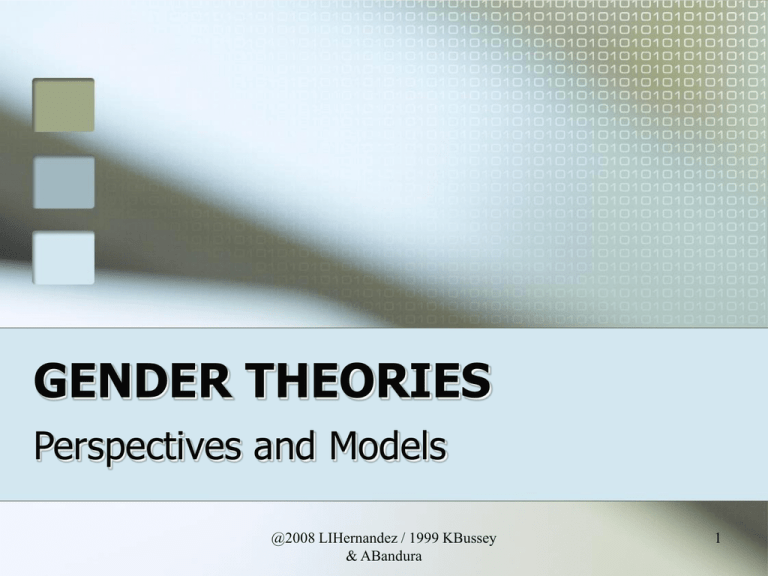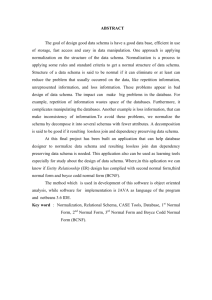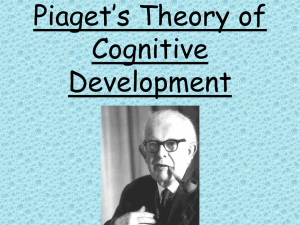
GENDER THEORIES
Perspectives and Models
@2008 LIHernandez / 1999 KBussey
& ABandura
1
Psychoanalytic Theory
Psychoanalytic theory is a general
term for approaches to
psychoanalysis which attempt to
provide a conceptual framework
more-or-less independent of clinical
practice rather than based on
empirical analysis of clinical cases.
@2008 LIHernandez / 1999 KBussey
& ABandura
2
Psychoanalytic Theory
Development is described as a
primarily unconscious - that is,
beyond awareness - and is heavily
colored by emotion.
Followers of psychoanalytic theory
Sigmund Freud
Jacques Lacan
Julia Kristeva
Bracha Ettinger
@2008 LIHernandez / 1999 KBussey
& ABandura
3
Psychoanalytic Theory
Gender development in boys and girls
are initially believed to identify
themselves with their mothers.
Between 3-5 years of age, this
changes and children identify with the
same-sex parent.
Boys genitalia causes castration
anxieties
Girls’ lack of penis make them inferior
@2008 LIHernandez / 1999 KBussey
& ABandura
4
Psychoanalytic Theory
Due to their identification with the
same-sex parent, children become
sex-typed (thus, boys are more sextyped)
Need further evidence on cross sextyped parent
@2008 LIHernandez / 1999 KBussey
& ABandura
5
Cognitive Developmental Theory
Gender identity is postulated as the
basic organizer and regulator of
children's gender learning (Kohlberg,
1966). Children develop the
stereotypic conceptions of gender
from what they see and hear around
them.
@2008 LIHernandez / 1999 KBussey
& ABandura
6
Cognitive Developmental Theory
Once they achieve gender constancy - the belief that their own gender is
fixed and irreversible -- they
positively value their gender identity
and seek to behave only in ways that
are congruent with that conception.
Kohlberg defined gender constancy as the realization that
one’s sex is a permanent attribute tied to underlying
biological properties and does not depend on superficial
characteristics such as hair length, style of clothing, or
choice of play activities.
@2008 LIHernandez / 1999 KBussey
& ABandura
7
Cognitive Developmental Theory
Three discrete levels of gender understanding
comprise gender constancy (Slaby & Frey, 1975).
"Gender identity" requires the simple ability to label
oneself as a boy or girl and others as a boy, girl, man, or
woman.
"Gender stability" is the recognition that gender remains
constant over time -- that is, one's sex is the same now
as it was when one was a baby and will remain the same
in adulthood.
“Gender consistency", is mastered at about age six or
seven years. The child now possesses the added
knowledge that gender is invariant despite changes in
appearance, dress or activity. Children are not expected
to adopt gender-typed behaviors consistently until after
they regard themselves unalterably as a boy or a girl.
@2008 LIHernandez / 1999 KBussey
& ABandura
8
Gender Schema Theory
The Gender schema theory proposes
that children learn from the culture in
which they live a concept of what it
means to be male and female. In
other words, children adjust their
behavior according to their gender
norms and expectations.
@2008 LIHernandez / 1999 KBussey
& ABandura
9
Gender Schema Theory
This theory states that the developing
child internalizes gender lenses that
are embedded in the discourse and
social practices of the culture, and
that these lenses predispose the
individual to construct a self-identity
that is consistent with these lenses
@2008 LIHernandez / 1999 KBussey
& ABandura
10
Gender Schema Theory
Gender schemata is essential in gender
role development and it emerges in
early childhood.
In your own childhood, as you struggled
to comprehend the world, you – like
other children – formed concepts, or
schema, including a schema for your
own gender. Gender then became a lens
through which you viewed your
experiences.
@2008 LIHernandez / 1999 KBussey
& ABandura
11
Gender Schema Theory
Through language, dress, toys, and
songs, social learning shapes gender
schemas. Children then compare
themselves with their concept of
gender ("I am male - thus, masculine,
strong, aggressive," or "I am female therefore, feminine, sweet, and
helpful") and adjust their behavior
accordingly
@2008 LIHernandez / 1999 KBussey
& ABandura
12
Gender Schema Theory
Negative consequences
gender-stereotyped behaviors and attitudes
may occur
this ultimately leads to the androcentrism
part of the Gender Schema theory which
suggests that the standards are created from
the male point of view, so everything
different from this category is considered a
deviation from the standard as well as an
inferior departure.
@2008 LIHernandez / 1999 KBussey
& ABandura
13
Biological Theory
Evolutionary Psychology
Gender differentiation is as ancestrally
programmed in terms of
Mate
preferences (natural selection)
Reproductive strategies (multiple sex)
Parental control
Aggressive nature of males (e.g., social
dominators, prolific maters in propagating
their genes)
@2008 LIHernandez / 1999 KBussey
& ABandura
14
Sociological Theory
Social construction
Gender stereotypes shape the perception,
evaluation and treatment of males and
females in selectively gendered ways that
beget the very patterns of behavior that
confirm the initial stereotypes. Many gender
differences in social behavior are viewed as
products of division of labor between the
sexes that get replicated through sociostructural practices governed by disparate
gender status and power
@2008 LIHernandez / 1999 KBussey
& ABandura
15
Social Cognitive Theory
This theory posits that portions of an
individual's knowledge acquisition can
be directly related to observing others
within the context of social
interactions, experiences, and outside
media influences.
@2008 LIHernandez / 1999 KBussey
& ABandura
16
Social Cognitive Theory
It is a learning theory based on the ideas
that people learn by watching what others
do and that human thought processes are
central to understanding personality.
People learn by observing others.
Learning is an internal process that may or may
not change behavior.
People behave in certain ways to reach goals.
Behavior is self-directed (as opposed to the
behaviorist thought that behavior is determined
by environment.)
Reinforcement and punishment have
unpredictable and indirect effects on both
behavior and learning.
@2008 LIHernandez / 1999 KBussey
& ABandura
17












